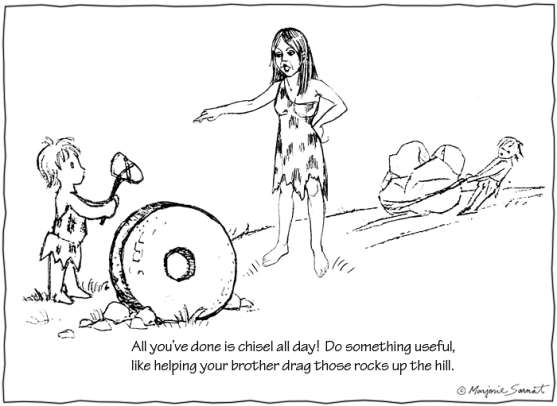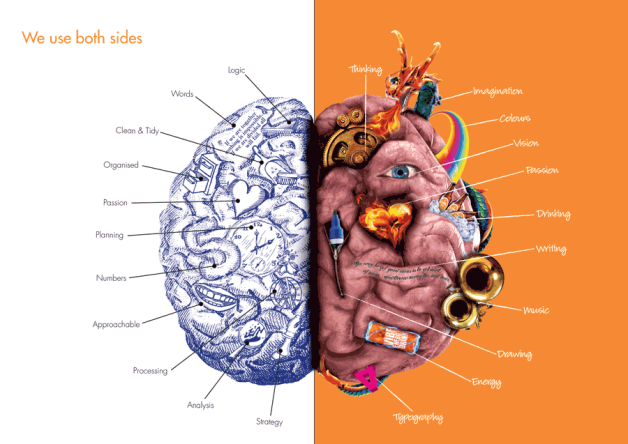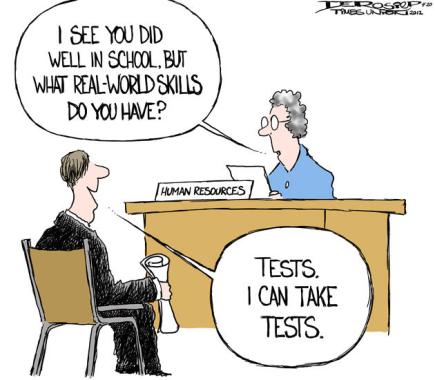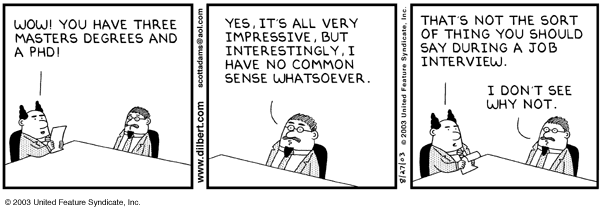The Common Core demands students think critically while staying connected and diving into text, yet employers desire workers who can think creatively while connecting with people as they dive into their work.
In college and careers students will often face the challenge of answering open-ended questions rather than text-dependent ones. Much of the text they encounter in school and work will not be “rich and worthy” of close reading.
College students and employees will often be required to make decisions and determine a course of action using vague, conflicting, or even incomplete data that is derived from a variety of sources.
Education programs should cultivate independent thinkers who can formulate creative solutions to novel problems rather than training text-dependent thinkers who can answer standardized text-based questions.
David Coleman has made it clear that Common Core students are expected to remain tethered to the text and read like a detective while most employers expect their workers to be autonomous learners as they read with perspective.
There is a significant difference between thinking critically while close reading complex text and thinking creatively while solving a complicated task…
Creative thinking is divergent, critical thinking is convergent; whereas creative thinking tries to create something new, critical thinking seeks to assess worth or validity in something that exists; whereas creative thinking is carried on by violating accepted principles, critical thinking is carried on by applying accepted principles. Although creative and critical thinking may very well be different sides of the same coin they are not identical (Beyer, 1987, p.35).
The Common Core’s emphasis on text-based thinking at the expense of experiential learning is not in the best interest of students or their future employers.
Text may be complex and rigorous but it is a passive, dull, and lifeless way to learn, while activities are a much more dynamic, interactive, and vigorous way to learn.
The Common Core Standards do not cultivate innovative and creative thought because it’s lead author has made it clear that original thoughts and personal feelings don’t matter in life.
Supporters of the Common Core continue to claim it will prepare students for colleges and careers despite numerous surveys, reports, and research (evidence) that employers are seeking workers who think creatively…
Overwhelmingly, both the superintendents of schools who educate future workers and the employers who hire them agreed that creativity is increasingly important in U.S. workplaces, and that arts training—and, to a lesser degree, communications studies—are crucial to developing creativity…Employers look for employees who reinforce their creativity by showing certain characteristics in the selection process:
Able to look spontaneously beyond the specifics of a question (78 percent)
Respond well to hypothetical scenarios (70 percent)
Able to identify new patterns of behavior or new combination of actions
Integrate knowledge across different disciplines
Show ability to originate new ideas
Comfortable with the notion of “no right answer”
Fundamentally curious
Demonstrate originality and inventiveness in work
Show ability to take risks
Tolerant of ambiguity
Show ability to communicate new ideas to others
Supporters of the Common Core may point to standards that call for creative and divergent thinking yet the multiple choice questions on the Common Core standardized tests DISCOURAGE and DISCOUNT such thinking as they have only one right answer and plausible responses are graded as wrong.
Standards should serve as a flexible framework to meet the academic, social, emotional, and vocational needs of diverse learners and NOT a forced march to meet the data driven demands of standardized tests.
To date, Common Core instruction and implementation efforts have been focused primarily on the standardized “needs” of tests rather than the diverse needs of young learners. Standards should be a guide or pathway to learning and success, rather than a high stakes destination to failure.
Defenders of public education have questioned whether the data driven Common Core implementation efforts will actually lead to more students dropping out of school rather than increasing student achievement.
Paul Bruno, a supporter of the Common Core responded to this concern…
And it’s also likely that, Common Core notwithstanding, our dropout rates will increase in the coming years since they are currently at an all-time low and an improving economy will give marginal students better alternatives outside of school.
For the record, it is entirely possible that the CCSS will contribute modestly to future increases in the dropout rate. The Common Core will – by design – make some courses more difficult for many students, and for marginal students that may be enough to nudge them out of school altogether.
The Common Core Will Not Double the Dropout Rate ~ Paul Bruno
Michael Petrilli, President of the Thomas B. Fordham Institute has expressed views on preparing ALL students for college and the discipline of at-risk learners that also seem contrary or inconsistent with his enthusiastic support for the K-12 college prep for all approach of the Common Core.
What if encouraging students to take a shot at the college track—despite very long odds of crossing its finish line—does them more harm than good? What if our own hyper-credentialed life experiences and ideologies are blinding us to alternative pathways to the middle class?…
We shouldn’t force anyone into that route, but we also shouldn’t guilt kids with low odds of college success—regardless of their race or class—to keep trudging through academic coursework as teens…
Rather than pretend that we’re going to get “all students” to “climb the mountain to college,” we should build a system that helps many students find another road to the middle class—a path that starts with a better prekindergarten-through-eighth-grade education and then develops strong technical and interpersonal skills in high school and at community colleges. This is an honorable path, and one that’s much sturdier than the rickety bridges to failure that we’ve got now.
“Kid, I’m Sorry, but You’re Just Not College Material” Is exactly what we should be telling a lot of high school students. ~ Michael Petrilli
In my view, we should be proud of the charter schools that are identifying and serving high-potential low-income students—kids who are committed to using education to escape poverty and are often supported in that effort by education-minded parents…
The reason to celebrate these schools and the role they play is because the traditional system has been downright hostile to the needs of such striving children and families…tracking or ability grouping is seen as elitist; any effort to provide special classes, environments, or challenges for motivated or high-achieving kids is cast as perpetuating inequality—even when all the kids are poor, and even though there’s a ton of evidence that high achievers do best around other high achievers.
And now these “social justice” types want to berate schools for asking disruptive students to leave. For sure, there should be checks on pushing kids out willy-nilly…
But let’s not forget about the needs (even rights) of the other kids to learn. Isn’t it possible that U.S. public schools have gone too far in the direction of accommodating the disruptors at the expense of everyone else?
Or been guilty of “defining deviancy down,” in Daniel Patrick Moynihan’s words? As Eduwonk Andy wrote this week, it’s probably because charter schools are willing (and able) to enforce discipline that they are so popular with parents. That wouldn’t be true if they had to retain chronic disrupters.
To be sure, this raises tough questions for the system as a whole. As I said in the Washington Post video, there are reasons to be concerned that district schools will become the last resort for the toughest-to-serve kids.
But in life there are trade-offs, and I would be willing to accept a somewhat less ideal outcome for the most-challenged students if it meant tremendously better life outcomes for their peers.
Flypaper: The charter expulsion flap ~ Michael Petrilli
It is odd that reformers who fervently support the Common Core with its mandate of college and career readiness for ALL students would express views that excuse the most challenged segments of our student population from meeting these higher standards.
Wasn’t the rationale for adoption of the Common Core that higher standards would serve as an academic rising tide that will lift all boats regardless of condition, design, or years at sea?
Or is it possible that the Common Core, which lacks meaningful career and technical standards or pathways, is intentionally designed to prepare cognitively privileged and standardized students for college and post-college careers while the “marginal” learners in our schools will be encouraged to apply at Dave and Buster’s?
In a rigorous Common Core world “marginal” learners are expendable and in the vigorous history of America these individuals were exceptional.
Rather than rating and sorting students according to a common and narrow set of testable academic skills we should be celebrating and cultivating uncommon talents and divergent thinking in our classrooms.
As Arnold Dodge explains, schools should be honoring and uplifting the creative “characters” in their classrooms…
Many of our schools have become dry, lifeless places. Joy and spirited emotions have been replaced by fear, generated by masters from afar. These remote overseers — politicians, policy makers, test prep executives — have decided that tests and numbers and drills and worksheets and threats and ultimatums will somehow improve the learning process…
When a student does well on a reading test, the results tell us nothing about how well she will use reading as a tool to learn larger topics, nor does it tell us that she will be interested in reading at all. What it tells us is that she is good at taking a reading test…
With the battle cry “College and Career Ready,” the champions of standardization are determined to drum out every last bit of creativity, unpredictability, humor, improvisation and genuine emotion from the education process in the name of useful “outcomes.”..
The self-righteous, powerful and moneyed, if they have their way, will eliminate from schools kids who have character — or kids who are characters, for that matter…
But there is another way. If we believe that children are imaginative creatures by nature with vast amounts of talent waiting to be mined, and if we believe that opening children’s minds and hearts to the thrill of learning — without competition and ranking — is a healthy approach to child development, then we are off to a good start…
William Glasser, M.D., studied schools for over 30 years and in his seminal work, The Quality School, he outlines five basic needs that all human beings are born with: survival, love, power, fun and freedom.
How many policymakers today would subscribe to having fun or experiencing freedom as a goal of our educational system? Just think of the possibilities if they did. Kids actually laughing in school and not being punished for it. Students feeling strong enough to talk truth to power and not being silenced. Youngsters feeling free to write with creativity and originality without being ridiculed for deviating from state test guidelines.
And that’s before we even get to love.
Think of the characters that would emerge from such an environment. Comedians, orators, raconteurs, revolutionaries, magicians, clowns, young people with agency and drive, having fun, not afraid to take risks or make mistakes. Not afraid to be children…
The BLOG: Needed in School: 140 Characters ~ Arnold Dodge


























